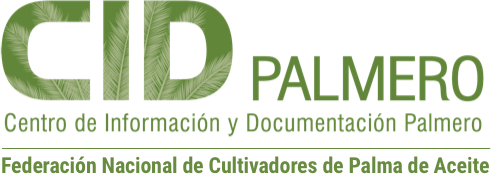Respuesta fisiológica de la palma de aceite a la aplicación de herbicidas al plato
Publicación:
Revista Palmas; Vol. 41 Núm. 2 (2020); 27-37
0121-2923
Revista Palmas; Vol. 41 Núm. 2 (2020); 27-37
0121-2923
Abstract
Weeds are pioneer plants of secondary succession that affect the crop development and production by competing for water, light and nutrients. In oil palm crops, weed control is carried out between rows, plot borders, ditches, and circles around the palm trunks, using physical (machetes or scythe) or chemical (herbicides) methods. There are few reports about the effects of circle-weeding of palm circles with chemicals on the development of the plant and the crop; therefore, the objective of this study was to determine the effect of circle-weeding with active ingredients of herbicides on the physiology of oil palms in productive age. The effect of four herbicide applications during one year was evaluated: glufosinate ammonium, ametryn, haloxyfop, indaziflam, metsulfuron, fluazifop, fluroxypyr and glyphosate, applied on a circular area around OxG interspecific hybrid oil palms (Brasil x Djongo) planted in Paratebueno, Cundinamarca. Six and twelve months after the first application, the values of gas exchange, vegetative and reproductive growth were recorded. The physiological variables did not show significant differences due to the application of herbicides around the plant. Therefore, the responsible use of herbicides could be considered within an integrated weed management program. Las malezas son plantas pioneras de la sucesión secundaria que interfieren con el desarrollo y producción de los cultivos porque compiten con ellos por agua, luz y nutrimentos. En el cultivo de palma de aceite, el control de malezas se lleva a cabo en las interlíneas, bordes de lotes, canales o platos, empleando métodos físicos (machete o guadaña) o químicos (herbicidas). Existen pocos reportes acerca de las consecuencias causadas por el plateo químico sobre el desarrollo de la planta y el cultivo, por lo que el objetivo de este trabajo fue determinar el efecto de la aplicación de ingredientes activos de herbicidas en el plato sobre la fisiología de palmas en edad productiva. Durante un año, se evaluó el efecto de cuatro aplicaciones de los herbicidas: glufosinato de amonio, ametrina, haloxifop, indaziflam, metsulfuron, fluazifop, fluroxipyr y glifosato, a los platos del híbrido interespecífico OxG (Brasil x Djongo), sembrado en Paratebueno, Cundinamarca. Seis y doce meses después de la primera aplicación, se registraron los valores de intercambio gaseoso, crecimiento vegetativo y reproductivo. Las variables fisiológicas no presentaron diferencias significativas por efecto de la aplicación de herbicidas al plato, de modo que su uso responsable podría considerarse dentro del manejo integrado de malezas.
Weeds are pioneer plants of secondary succession that affect the crop development and production by competing for water, light and nutrients. In oil palm crops, weed control is carried out between rows, plot borders, ditches, and circles around the palm trunks, using physical (machetes or scythe) or chemical (herbicides) methods. There are few reports about the effects of circle-weeding of palm circles with chemicals on the development of the plant and the crop; therefore, the objective of this study was to determine the effect of circle-weeding with active ingredients of herbicides on the physiology of oil palms in productive age. The effect of four herbicide applications during one year was evaluated: glufosinate ammonium, ametryn, haloxyfop, indaziflam, metsulfuron, fluazifop, fluroxypyr and glyphosate, applied on a circular area around OxG interspecific hybrid oil palms (Brasil x Djongo) planted in Paratebueno, Cundinamarca. Six and twelve months after the first application, the values of gas exchange, vegetative and reproductive growth were recorded. The physiological variables did not show significant differences due to the application of herbicides around the plant. Therefore, the responsible use of herbicides could be considered within an integrated weed management program.
Palabras clave:
Chemical control
weeds
integrated management
sustainable production
residuality
control químico
maleza
manejo integrado
producción sostenible
residualidad
Chemical control
weeds
integrated management
sustainable production
residuality
control químico
maleza
manejo integrado
producción sostenible
residualidad



